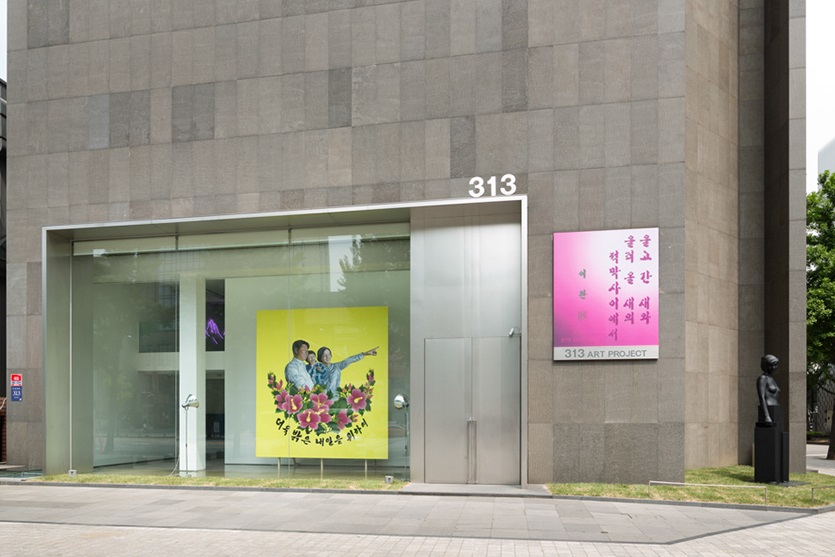Variations, Situated and In Situ Works
공간의 미학
June 10 – September 25, 2015
“I don’t believe in the existence of work that has no audience. Only once it is viewed can a work be said to exist.” — Daniel Buren, 2005
Daniel Buren’s oeuvre over a 50-year span represents contemporary art itself. Taking the lead on the anti-modernist movement of the 1960s, Buren criticized the traditional institutions and led a movement against art museum works, expressing his dissent to the value of ‘autonomy’ pursued by modern art. He was in absolute discord with the traditional authority of modern art institutions that restrictedly reinforced purity of the medium, and thus he led the break from the museums–the modern symbol of authority. Roland Barthes, who attempted to tear down traditional authority through his essay on the death of the author, had a profound influence on the artist. Buren amplifies the value of the existence of art and its meaning through his own artistic intervention.
The representative art world of Buren is defined by a key element, the vertical stripe of 8.7cm, that alternates between white and colored. The artist considered stripe as the most neutral form of visual expression that embodies no meaning and believed that its mere presence can be seen as a work of art. (Buren actually defined the stripe as, “an artwork that cannot be told except for its presence.”) The artist, by unfolding various artistic scenes, not only overcomes the limited boundary of traditional painting genre but also reconsiders the role of contemporary artists and their production of artworks.
The intended role of stripes becomes predominant in his In-Situ works based on site-specific installations. Pursuing art practices outside the established institutions, Buren overcomes the formal limitation of stripes by setting buildings and their surrounding environments as canvas. Based on inspirations from the space, Buren externalizes its physical and relational elements. Here, the natural elements such as light, air and wind become crucial resources to bring his artworks into completion. The concept of “site” that overarches time and space holds significant meaning for the artist. The artist installs his works in person at the exhibition space and takes them apart immediately after the exhibition. The artist strongly claims that his works must form a complementary balance in relation to the space and believes that active participation of the audience enables it.
Buren had solo exhibitions at Centre Pompidou, Paris in 2002 and a retrospective exhibition at Solomon R. Guggenheim Museum, New York in 2005. He also participated in Kassel Documenta and the Venice Biennales, where he was awarded with the Golden Lion Award in 1986 for his exhibition at the French pavilion. His latest exhibitions include ‹Monumenta› at Grand Palais, Paris (2012) and ‹Like Child’s Play, Works On-Site› in Strasbourg Museum of Modern and Contemporary Art (2014). In particular, his large scale public artwork ‹Les Deux Plateaux› at Palais Royal, Paris, is regarded as the quintessence of his artistic profundity. In Korea, Buren was introduced through the opening exhibition of Atelier Hermes in 2006, and he participated in ‹The Poetics of Space› in Whanki Museum the same year. In 2015, the artist held his first gallery solo exhibition in Korea <Variations, Situated and In Situ Works> at 313 ART PROJECT, Seoul.
“관객이 없는 상태에서는 예술작품이 존재할 수 없다고 생각한다. 관객이 보는 과정을 거쳐야만 예술작품은 비로소 존재한다고 말할 수 있다.” — 다니엘 뷔렌, 2005
다니엘 뷔렌의 지난 50년 동안의 작업 활동은 현대미술 그 자체를 대변한다. 매체의 순수성만을 제한적으로 강조한 모더니즘 미술사관의 전통적 권위를 무너뜨리고자 했던 뷔렌은 건축물이 가지는 공간의 의미를 본인만의 시각 예술적 개입을 통해 입체적으로 표현한다. 한국에서 열리는 다니엘 뷔렌의 첫 갤러리 개인전 ‹Variations, 공간의 미학›에서 작가는 공간으로부터의 영감을 바탕으로 한 23점의 서로 다른 작품을 설치한다. 이를 통해 그는 공간이 내재한 여러 물리적 그리고 관계적 요소들을 표면화하며, 궁극적으로 이 모든 것을 포괄하는 하나의 예술적 상황을 형성한다.
이번 전시를 통해 보여지는 흑백으로 나열된 8.7cm의 줄무늬는 작가와 그의 작품 세계를 정의하는 데 있어 결코 빠뜨릴 수 없는 요소이다. 그는 줄무늬를 어떠한 의미도 내재하지 않는, 가장 중성적인 형태의 시각적 표현으로 간주하였으며, 존재 그 자체가 하나의 미술품이 된다고 생각하였다.
장소 특정적 성향을 기반으로 한 그의 인 시튜(In-Situ) 작업에서 이러한 줄무늬의 역할은 더욱 부각된다. 인 시튜(In-Situ)는 작가의 대표적인 작업 방식이자 그가 작품을 통해 전달하고자 하는 주제이다. 작가는 시, 공간을 포괄하는 복합 용어인 ‘현장’의 개념을 중요시 여기며 모든 작업을 전시가 되는 현장에서 직접 제작, 설치하고, 전시 후 바로 해체한다. 작가는 본인의 작업이 장소와의 관계에서 상호보완적 균형을 이루어야 한다고 주장하며, 적극적 관람자의 역할이 비로소 이것을 가능케 한다고 이야기한다.
다니엘 뷔렌은 2002년 파리 퐁피두 센터에서 초대전, 2005년 뉴욕 구겐하임 미술관에서의 기념비적인 회고전을 비롯하여 10여차례 이상 베니스 비엔날레와 카셀 도큐멘타에 참가하였으며, 특히 1986년에는 베니스 비엔날레 프랑스관 전시로 비엔날레 최고 영예인 황금사자상을 수상하기도 하였다. 최근 전시로는 2012년 파리 그랑팔레 ‹모뉴멘타 (Monumenta)›전, 2014년 프랑스 스트라스부르 현대미술관, ‹Like Child’s Play, Works On-site›전이 있다. 파리 팔레 루아얄에 영구 설치된 그의 대규모 공공 미술 작품 ‹두 개의 고원 (Les Deux Plateaux)›은 그의 예술적 깊이를 보여주는 진수로 평가 받는다. 국내에서는 2006년 아뜰리에 에르메스 개관전을 통해 소개된 바 있으며, 같은 해 환기미술관의 ‹공간의 시학›전에 참가하였다.










 Daniel Buren, Zig-Zag, situated work, 18 elements: 3×3 colors and 9 mirrors, haut-relief Seoul No. 16, 2015,
Daniel Buren, Zig-Zag, situated work, 18 elements: 3×3 colors and 9 mirrors, haut-relief Seoul No. 16, 2015,
Wood, pixelglass, black self-adhesive vinyl, glue, 9 mirror boxes, 3 red boxes, 3 green boxes, 3 black boxes, 219 x 800 cm




